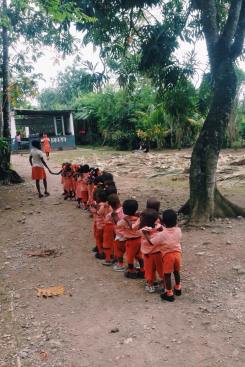12 January 2010: A 7.0 earthquake knocks Haiti near Port-au-Prince, claiming over 200,000 lives and injuring more than 300,000. Relief pours in from the United States, Peru, Argentina, Brazil. Haiti is on all radars, in the news, in prayers, in songs.
16 January 2015: We land in the Les Cayes airport on a humid afternoon, taxiing the Cessna to the side of the runway, and cross the tarmac to exit through a large orange room, the sun bouncing off tiled floors, fans poised above the windows but completely still, lifeless, staring. There is no passport check, no baggage claim. We walk around the porch and see a few kids watching us between the chain-link fence. They wave and yell, “Blan, blan!” (“White, white!”) This greeting is standard, and it’s true. We’re the local spectacle.
But as we zigzag through traffic, the life on the street is what captivates. Schoolgirls in uniform laugh together on the walk home. Older women balancing jugs of water and baskets of clothes on their heads turn to look, straight-faced, expressionless. We pass carts of mangos, giant glistening tour buses, legions of motorbikes. Chris comments on the rebars poking out of many cement houses, and Conwell explains how a house might take 30 years to build, as they buy materials and build onto what they have.
Our group from Fairmont, MN, is not here for relief, per se. We’re here to spend a few days at the orphanages near Torbeck, and although we’ve brought supplies for the kids and game things (piñatas, balloons, candy), there is very little notion of what these days will hold.
Friday night is Movie Night for the girls, so we pile into every nook of the two pickup trucks and head to the Consolation Center. As we watch Up in French, each of us has about 2.6 girls on our laps, with even more sitting next to us, telling us their names, patiently helping us to get each one right, even though we forget half of them the next minute.
Even from the beginning, I start to realize how much ground there is to cover, how small a week really is in the scheme of things, how small I am.
Haiti is still living in the aftermath, not just of the 2010 earthquake, but a whole history of collapse, suspension, self-collection. Most solutions are temporary, and deadly. Ken tells us of a man near Port-au-Prince whose livelihood was to sell rice. Once aid and food flooded in, people would not buy rice from him when they could get it for free. So his work was gone.
 It’s an all-too-common story, one that I find easy to brush off sitting at the apartment dining room table after the trip. But in Torbeck, we aren’t just exchanging stories after dinner, we’re cringing as two or more girls weave our hair into intricate braids, we’re making toys out of caps and plastic bags and sticks up in the hills, we’re stomping in puddles as rain drips off the thatched roof and creeps to cover the pavilion floor, we’re bruising our feet on the rocks as the kids run over the beach, fearless. At any given moment, we are greeted with the hugs and outstretched arms from the kiddos we eventually come to expect.
It’s an all-too-common story, one that I find easy to brush off sitting at the apartment dining room table after the trip. But in Torbeck, we aren’t just exchanging stories after dinner, we’re cringing as two or more girls weave our hair into intricate braids, we’re making toys out of caps and plastic bags and sticks up in the hills, we’re stomping in puddles as rain drips off the thatched roof and creeps to cover the pavilion floor, we’re bruising our feet on the rocks as the kids run over the beach, fearless. At any given moment, we are greeted with the hugs and outstretched arms from the kiddos we eventually come to expect.
We spent a good deal of time consciously using body language to explain something (cue Ursula: “Don’t underestimate the importance of . . . BODY LANGUAGE!”). Some of the older girls spoke English, and I speak some French (and tried to learn some Creole phrases, with interesting results), but both sides had to go beyond what could be said to what was meant. This past week was a lesson for me in how much love can be shown without saying a word.
Casandra walked with me through fallow fields to the babies’ and widows’ center, not letting go of my hand. We sang the same tunes together in Creole and English. Adonaika showed me the best way to eat mangos and then laughed when strings got stuck in my teeth. Her sister Tica was almost always found sitting on laps or hugging someone tight. Baby danced the Habañera with me, giggling when I’d dip her or spin her around. More than anything, I am thankful for those smiles and giggles and hugs. None of that needs an explanation.
I could talk about the piles of rubbish in the back alleys, the sugar cane cud in street corners, the rocks underfoot at every turn. But what I think about mostly is that unquestioning love, and how precious that is.
And I will write more about what we saw and the centers we visited. But at the risk of melodrama, I’m living in the aftermath of the trip, so to speak. It’s funny how many things remain undone as we pulled out last Friday – there are building projects just beginning at the school, we never found my dad’s two boys at the Center, and even spending time with the “moms” of the orphanage did not give us the opportunity to hear their stories. There’s more, there’s always more.